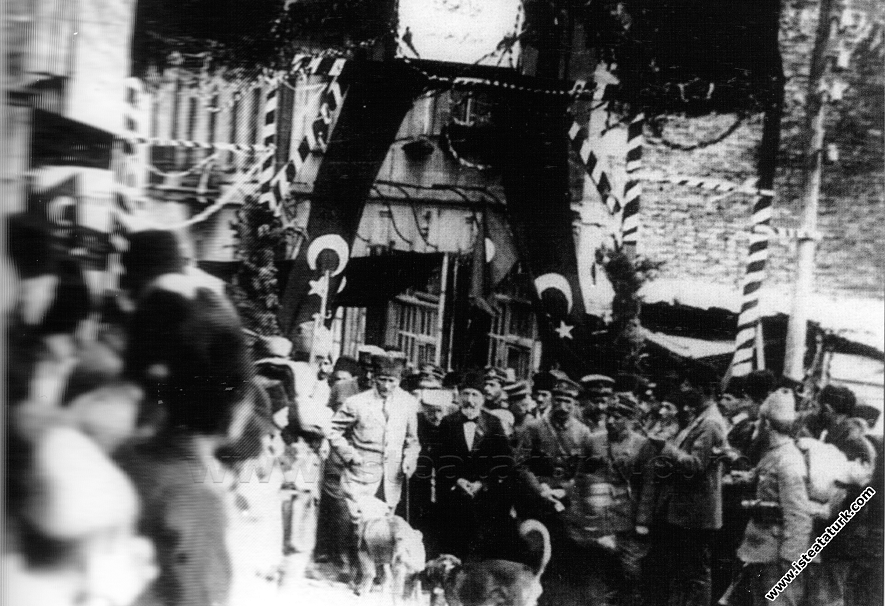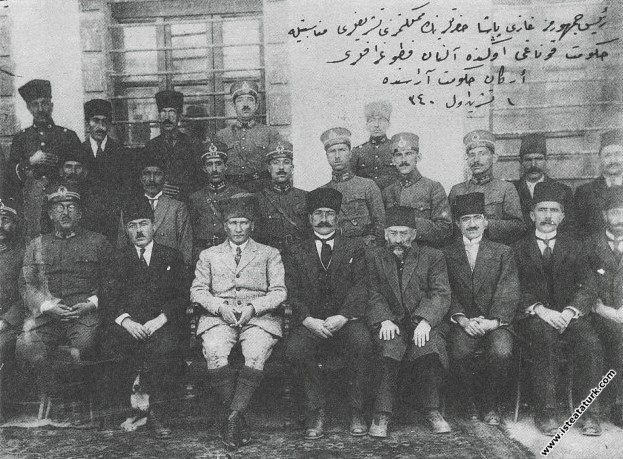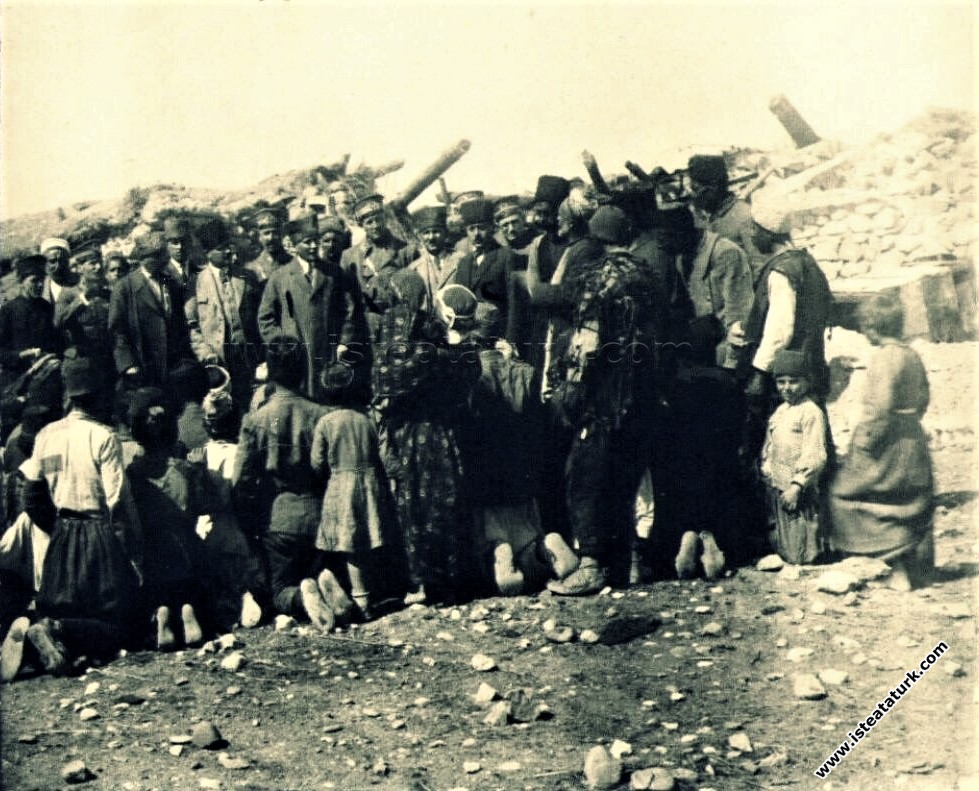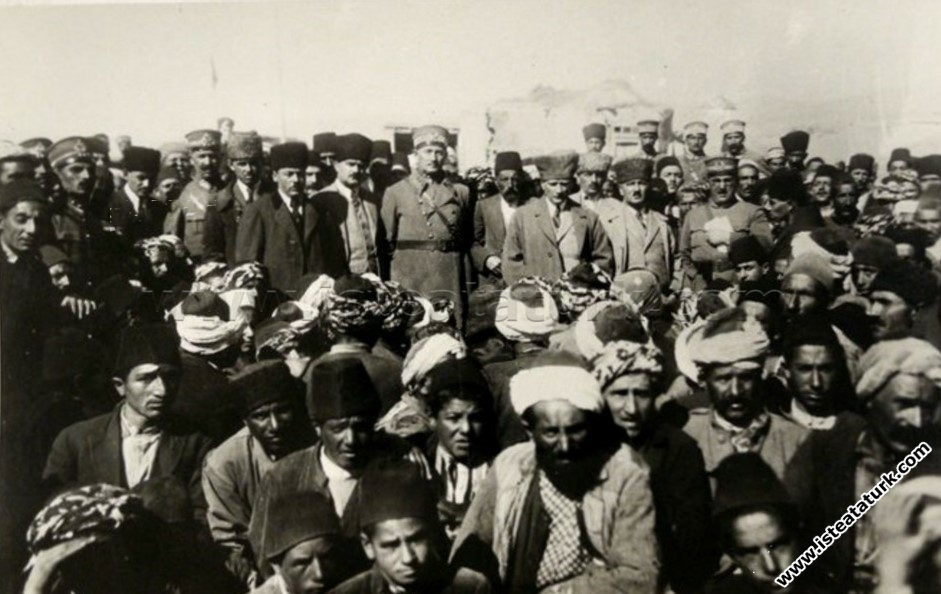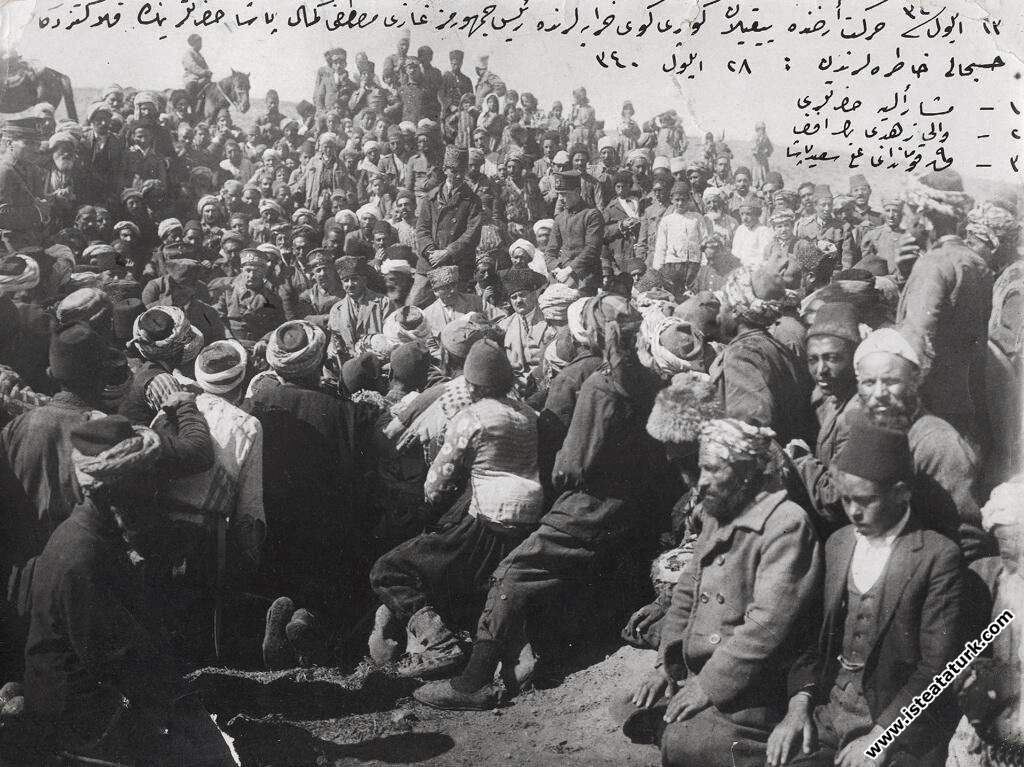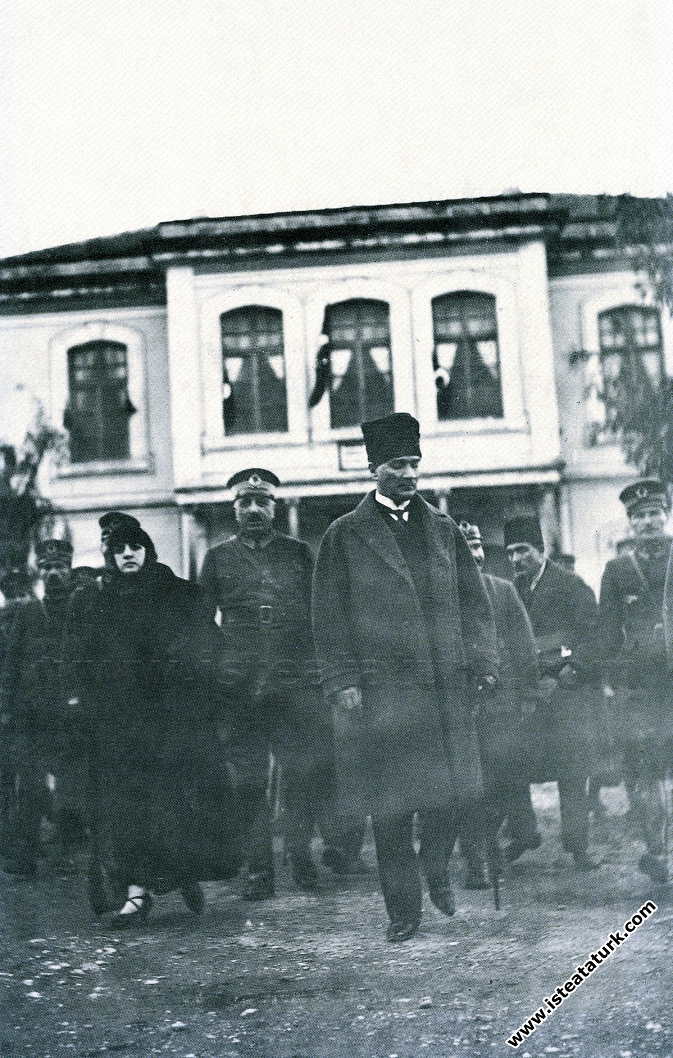Mustafa Kemal Pasha's visits in Şebinkarahisar. (12.10.1924)
| Photo source: Doğumundan Ölümüne Kadar Kaynakçalı Atatürk Günlüğü. Prof.Dr.Utkan Kocatürk. Atatürk Araştırma Merkezi. Ankara. ISBN: 975-16-1191-1 |
Mustafa Kemal Pasha's visits in Şebinkarahisar. (October 12, 1924)
I LIKE THIS CITY SO MUCH
"For the sake of this love, I propose that the name of Şark-i Karahisar be corrected as Şebinkarahisar. It should be our duty to take this city forward economically as well as historically."
Gazi Mustafa Kemal ATATURK
Sebinkarahisar, 12.10.1924
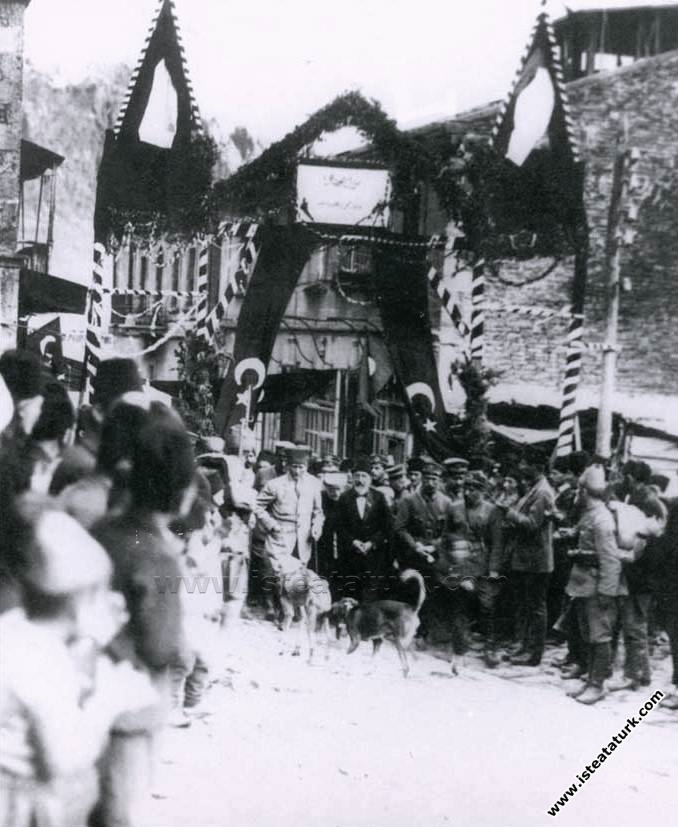
Welcoming of Mustafa Kemal Pasha in Şebinkarahisar (12 October 1924)
VISITS TO ŞEBİNKARAHISARI BY GAZİ MUSTAFA KEMAL PASHA
Mustafa Kemal Atatürk visited many provinces and districts on various occasions before and after the establishment of the Republic. The country tours that Atatürk made as the President after the proclamation of the Republic were definitely organized to serve a purpose. One of the main purposes of these trips was to explain the characteristics of the Republic of the new board to the public and to inform the public about the innovations that have been made and will be made.
Before each reform he carried out, he told the public about the new step to be taken during his country tours, examined their opinion and got their approval. As a representative of the nation, he bestowed upon his nation the sincere love shown by the people in the villages, towns and cities he visited, as he always did. Despite the fact that he did not want welcoming ceremonies to be held in the places he would visit on every trip, the people poured out on the roads he would pass, and especially the young people never left his side.
President Mustafa Kemal Pasha's visit to Şebinkarahisar, then known as Karahisar-ı Şarki, took place during his country tour, which he took ten months after the proclamation of the Republic.
This country trip of Mustafa Kemal Pasha lasted fifty days between 29 August and 18 October 1924 and a distance of 3000 km was covered by land. The President's wife Latife Hanım, as well as Yozgat deputy Salih Bozok, Istanbul Deputy and former Turkish Hearths Chairman Hamdullah Suphi, Gaziantep Deputy Kılıç Ali, Rize Deputy Rauf, Presidential Chief Tevfik, Chief Adjutant Rusuhi, Guard Unit Commander Major İsmail Hakkı, Captain Muzaffer, Private Clerk Memdul, members of the press and other officials attended.
The trip started with a visit to Dumlupınar on 29-30 August. Then, after various examinations made in Bursa on 31 August-11 September, they passed from Mudanya with the Hamidiye Battleship on 11-14 September without stopping by Istanbul and reached Trabzon. Trabzon on 15-17 September, Rize on 17-18 September, Giresun and Ordu on 19 September, Samsun on 20-24 September, Amasya on 24 September, 25- Tokat on 26 September, Sivas on 27-28 September, Suşehri on 28 September, Refahiye and Erzincan on 29-30 September, Erzurum on 30 September 1 October, on 2 October. Hasankale, Akköprü, Yapan, Mindivan, Komasor and Döllet villages in Erzurum again on 3-4 October, Sarıkamış on 4-5 October, Kars on 6 October, and Sarıkamış again on 7-8 October. , Şebinkarahisar, which is our subject of communication, on 11-12 October, Kayseri on 13-14 October via Suşehri, Zara, Geş, Yozgat on 15-16 October,one
This long and tiring fifty-day trip actually served two important purposes. The first was to ensure that the Republic, which was not yet in its first year, was adopted and rooted, and the second was to create a new model for Turkish women in the person of their husband, Latife Hanım. During this trip, Latife Hanim was found with her face open and always next to President Mustafa Kemal Pasha and in front of him while walking. The presence of Ms. Latife on the trip was also the main incentive for women to participate in the welcoming ceremonies.
Mustafa Kemal Pasha's visit to the province of Şark-i Karahisar as it was then took place on his return from Erzurum. While Atatürk was going from Sivas to Erzurum, a delegation led by Ali Sururi came to Suşehri and invited him to their city. Despite the fact that the Mosul problem, which could not be resolved in Lausanne at that time, caused tension between us and England again, Atatürk accepted this invitation with great pleasure, and on his return from Erzurum, on the morning of 11 October 1924, departing from Erzincan, he came to the city at 21:00 in the evening. Hearing that Atatürk was coming to their city, the people took the road to Şebinkarahisar-Suşehri and greeted the President with great enthusiasm. When Atatürk entered the city, he was greeted with cannon fire, and the people of Şebinkarahisar, who lit torches in the high castle of the city and in the streets, turned the visit into a great festival. 2
Atatürk, who was hosted at Çakmakçı Mustafa Ertem's house on Halil Rıfat Paşa Street that night, visited the municipality, the governorship, the People's Party, the Regiment Command and the Turkish Hearth, the next day, on September 12, that Majorzade Rıza Bey was president. During their visit to the Turkish Hearth, the young people said that they had shortcomings because they had just opened the hearth, and they apologized. Atatürk made the following meaningful speech addressing both the youth of the hearth and the citizens who listened to him here. “I really liked this beautiful city. As a token of my love, I propose that the name of the city, which is Karahisar-ı Şarki, be corrected as Şebinkarahisar. Everything else in these lands, where conquerors set up tents, especially Shabbit, should be dealt with, and it should be our duty to take this city forward economically as well as historically. You've seen constant fires, your hometown is in ruins, but don't fret. In your one-eyed, humble hearth, I found a deep intimacy, a broad and understanding culture. You will develop, you will be happy. Turkish hearths are not measured by modern deco. These furnaces of glory of the Turk will continue to burn with unquenchable flames, and these ruins will one day become mammoths. While leaving, he wrote the following in the Turkish Hearth Notebook. “Let the Turkish Hearth, the unique hearth of the Turk, the hearth of wealth and unity, smoke with high flames,. 3
The great Turkish national poet Mehmet Emin Yurdakul said, “Here I found the Turkish spirit, all ceremonies and virtues, which the ruthless time that changes and corrupts everything cannot change or refute. I got my national suffering, my national ideal from here. This is the real source of my nationalism," and Atatürk left Şebinkarahisar in the afternoon of the same day with a big farewell ceremony, which was held with the participation of all the people, despite their requests not to hold the ceremony. 4
After this visit, the great Atatürk could not come to Şebinkarahisar, the city he named after him. However, the people inspired by Şebinkarahisar's Turkish Hearth, who wanted to confirm his hope that "one day these ruins will become prosperous", established the modern Şebinkarahisar, which we are happy to see today.
Prof. Dr. Mustafa BALCIOĞLU*
* Kırıkkale University İ.İ.BF Head of International Relations
1 Fahrettin Kırzıoğlu, Gazi’nin Kuzey Doğu Gezileri, Erzurum 1974, s. 134
2 Hakimiyet-i Milliye, 13 Teşrin-i evvel, 1340 (1924)
3 Ali Özdemir-Hasan Özhan, İlçe Oluşunun 50. Yılında Şebinkarahisar, Ankara 1983, s. 27
4 Hakimiyet-i Milliye, 14 Teşrin-i evvel 1340 (1924)
